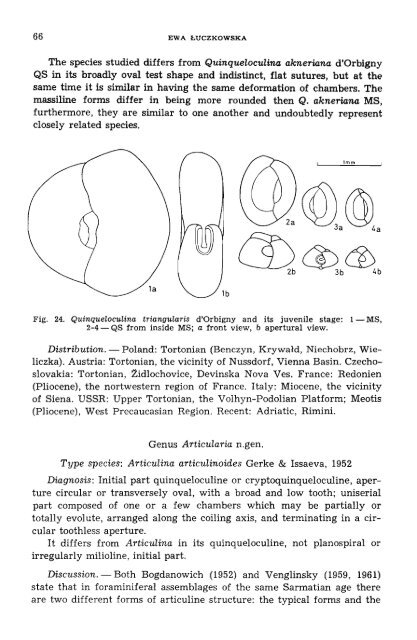MILIOLIDAE - Acta Palaeontologica Polonica
MILIOLIDAE - Acta Palaeontologica Polonica
MILIOLIDAE - Acta Palaeontologica Polonica
You also want an ePaper? Increase the reach of your titles
YUMPU automatically turns print PDFs into web optimized ePapers that Google loves.
66 EWA I:.UCZKOWSKA<br />
The species studied differs from Quinqueloculina akneriana d'Orbigny<br />
QS in its broadly oval test shape and indistinct, flat sutures, but at the<br />
same time it is similar in having the same deformation of chambers. The<br />
massiline forms differ in being more rounded then Q. akneriana MS,<br />
furthermore, they are similar to one another and undoubtedly represent<br />
closely related species.<br />
1a<br />
Fig. 24. Quinqueloculina triangUlaris d'Orbigny and its juvenile stage: 1 - MS,<br />
2-4 - QS from inside MS; a front view, b apertural view.<br />
Distribution. - Poland: Tortonian (Benczyn, Krywald, Niechobrz, Wieliczka).<br />
Austria: Tortonian, the vicinity of Nussdorf, Vienna Basin. Czechoslovakia:<br />
Tortonian, Zidlochovice, Devinska Nova Ves. France: Redonien<br />
(Pliocene), the nortwestern region of France. Italy: Miocene, the vicinity<br />
of Siena. USSR: Upper Tortonian, the Volhyn-Podolian Platform; Meotis<br />
(Pliocene), West Precaucasian Region. Recent: Adriatic, Rimini.<br />
Genus Articularia n.gen.<br />
Type species: Articulina articulinoides Gerke & Issaeva, 1952<br />
Diagnosis: Initial part quinqueloculine or cryptoquinqueloculine, aperture<br />
circular or transversely oval, with a broad and low tooth; uniserial<br />
part composed of one or a few chambers which may be partially or<br />
totally evolute, arranged along the coiling axis, and terminating in a circular<br />
toothless aperture.<br />
It differs from Articulina in its quinqueloculine, not planospiral or<br />
irregularly milioline, initial part.<br />
Discussion. - Both Bogdanowich (1952) and Venglinsky (1959, 1961)<br />
state that in foraminiferal assemblages of the same Sarmatian age there<br />
are two different forms of articuline structure: the typical forms and the
















